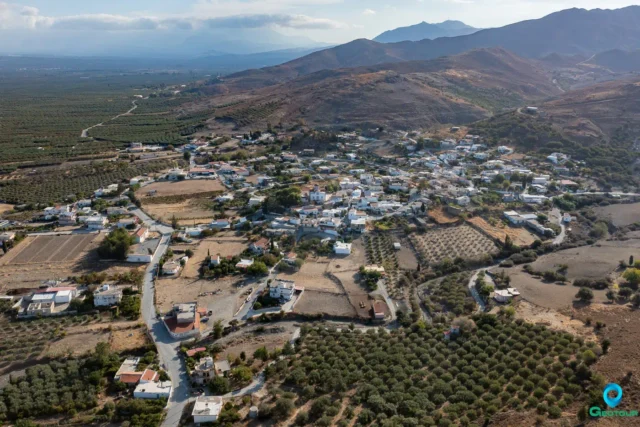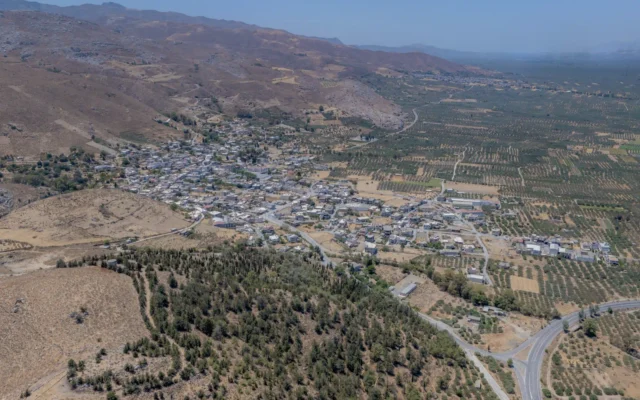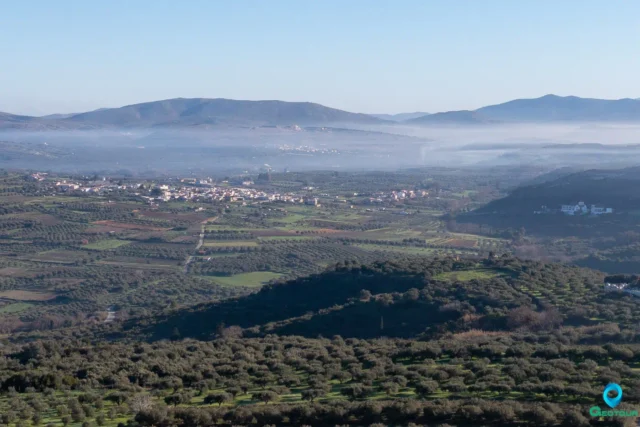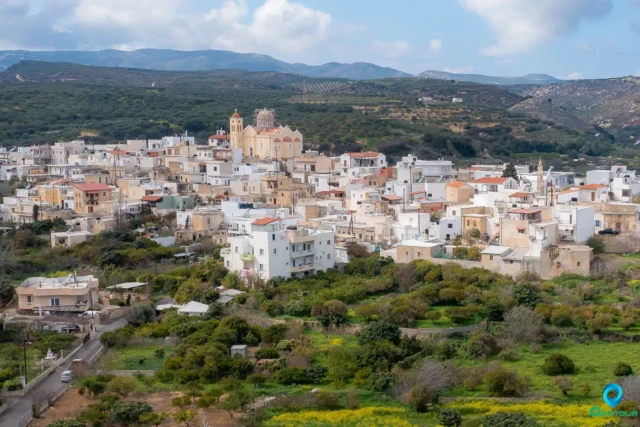748
listings found
Categories
Active filters:
Profitis Ilias, Heraklion
Profitis Ilias, formerly Kanli Kastelli, is a historic village in Heraklion, Crete, at the foot of Rokka hill. Ancient Lykastos' acropolis stood here. The Byzantines built Temenos fortress, later fortified by Venetians (Castello Temene). Ottomans renamed it Kanli Kastelli ("Bloody Fortress"). Known for agricultural production, particularly grapes, raisins, olive oil, and wine, the village has a population of 1,320. It features a Citizens' Service Centre, police station, schools, a medical clinic, and several churches.
Dafnes, Heraklion
Dafnes, a village in Heraklion, Crete, is known for its wine and olive oil production since the 13th century.
Dafnes is derived from the laurel plant (δάφνη - dafni).
The village is believed to have been founded by residents of another village named Skilochorio. Dafnes and Skilochorio are mentioned in documents from the 13th century.
Dafnes is known for its production of raisins, grapes, wine (using the Liatiko grape variety), and olive oil. The village has four wineries.
The village square hosts the annual Dafnes Wine Festival, usually held in the first ten days of July.
Sternes, Gortyna
Sternes, a village in Heraklion, Crete, has a history dating back to the 13th century. Its name comes from the Greek word "sterna," meaning cistern, referencing a large Roman-era cistern located west of the village.
Sternes is in the foothills of the Asterousia Mountains. The village has been documented in historical records as early as 1271. Today, Sternes remains an agricultural community with a population of around 420, focused on the cultivation of olives and grapes for raisins.
Sternes has several churches and chapels, including the church of the Presentation of the Virgin Mary, the church of Saint John, and the chapels of Agia Paraskevi and Panagia. The village also has a cultural association, a kindergarten, and an elementary school.
Pyrgos, Archanes – Asterousia
Pyrgos is a settlement located in the Heraklion regional unit on the island of Crete, Greece. It belongs to the Municipality of Archanes - Asterousia
Karkadiotissa, Heraklion
Karkadiotissa is a settlement located in the Heraklion regional unit on the island of Crete, Greece. It belongs to the Municipality of Heraklion
Choumeri, Minoa – Pediada
Choumeri is a settlement located in the Heraklion regional unit on the island of Crete, Greece. It belongs to the Municipality of Minoa - Pediada
Galatas, Minoa – Pediada
Galatas is a settlement located in the Heraklion regional unit on the island of Crete, Greece. It belongs to the Municipality of Minoa - Pediada
Zinta, Minoa – Pediada
Zinta is a settlement located in the Heraklion regional unit on the island of Crete, Greece. It belongs to the Municipality of Minoa - Pediada
Voni, Minoa – Pediada
Voni, a village in the Municipality of Minoa Pediada, Heraklion, Crete, sits at 330 meters above sea level. Known for its agricultural production, particularly grapes, cereals, and olive oil, Voni is also home to the Agia Marina Monastery, a significant pilgrimage site. The village's history dates back to the Late Minoan period, with evidence of settlement found in a bathtub-shaped sarcophagus. During the Ottoman period, Voni was known as "Dedeler Küyü" and was inhabited predominantly by Turkish families. After Crete's liberation from Ottoman rule in 1898, the village was repopulated by people from the Lasithi Plateau. Voni also includes the settlement of Galatas, which dates back to the late 16th century.
Kounavoi, Archanes – Asterousia
Kounavoi is a settlement located in the Heraklion regional unit on the island of Crete, Greece. It belongs to the Municipality of Archanes - Asterousia
Chochlakies, Siteia
Chochlakies, a small village in eastern Crete's Sitia province, is known for its untouched natural beauty. The village is nestled in a valley, with a gorge leading to Karoumes Beach. Chochlakies offers a glimpse into traditional Cretan life, with a restored watermill dating to 1919 and traces of Minoan settlements, including a fortification and cave. The Chochlakies Gorge, also called Karoumes Gorge, features the Flega stream and ends at Karoumes Beach. The gorge trail, part of the E4 European Path, passes through varied terrain, from olive groves to steep rock formations. The village is accessible by car from Xerokampos and is near Palaikastro and Zakros. Tourism remains minimal, preserving the tranquil atmosphere.
Alagni, Archanes – Asterousia
Alagni, a village 25 kilometers from Heraklion, Crete, has a history rooted in the Minoan civilization. The village's name is believed to be derived from the nymph Alagonia, and ruins of a temple dedicated to her are said to be found on Tholi hill. Alagni is near the Minoan palace of Galatas, built around 1700-1600 BC. The village itself is home to a Minoan farmhouse and appears in historical records as early as 1583.
Alagni has several notable churches: Agios Vlassis, Sotira, Agios Georgios, Panagia, Panagia of Rouma, and Agioi Apostoloi. The latter, built in the 15th-16th century, bears the emblem of the Venetian Cornaro family.
Other significant landmarks include the deserted settlement of Rouma and Koursamos, where a cluster of winepresses dating back to the 16th-17th centuries exists. The Tholi Fortress, a small fortress from the late Venetian period (16th-17th century), is located on a hilltop west of Alagni.
The village's economy has traditionally centered around agriculture, particularly the cultivation of grapes and olives for wine and oil production.
Piskokefalo, Siteia
Piskokéfalo, a large village in Siteia, Crete, was a Venetian fiefdom of the Kornaros family, including poet Vitsentzos Kornaros. The village features a restored Kornaros residence and watermill, intended as a museum. Near Katrinia hill, a rural temple with Minoan artifacts was unearthed, and a Minoan mansion's ruins remain. Piskokéfalo was the Turkish administration seat until 1871. The nearby ruined settlement of Trapezonda, also linked to the Kornaros family, was destroyed multiple times, including by Barbarossa. The village's population has fluctuated over time, reaching 642 residents in 2011.
Stavies, Gortyna
Stavies is a settlement located in the Heraklion regional unit on the island of Crete, Greece. It belongs to the Municipality of Gortyna
Kato Episkopi, Siteia
Kato Episkopi, a village in Siteia, Lasithi, Crete, sits at 40 meters altitude. Historically significant, it contains a converted 11th-century bathhouse, now the Church of the Holy Apostles Peter and Paul, likely a bishopric seat during the Second Byzantine period. Archaeological finds include vaulted tombs and a Roman building. The church's architecture features an octagonal dome and imitates ashlar masonry. The village has seen various populations, including Muslims and Christians, through Ottoman and later rule. Its history is documented through Ottoman surveys and censuses.
Krotos, Gortyna
Krotos is a settlement located in the Heraklion regional unit on the island of Crete, Greece. It belongs to the Municipality of Gortyna
Adravastoi, Siteia
Adravastoi, a small village in Sitia, Lasithi, eastern Crete, has a rich history dating back to ancient times, with traces of habitation found on the Entichis elevation. The village was likely destroyed by pirates in 1471 and repopulated later. Its economy is based on agriculture, livestock and small-scale tourism. The village features traditional architecture, including single and two-story stone buildings with earthen or modern roofs, and the two-aisled church of Agios Dimitrios and Zoodochos Pigi. Adravastoi is located near Palekastro and Zakros and is part of the Municipality of Sitia.
Miamou, Gortyna
Miamou is a settlement located in the Heraklion regional unit on the island of Crete, Greece. It belongs to the Municipality of Gortyna
Agios Kyrillos, Gortyna
Agios Kyrillos is a settlement located in the Heraklion regional unit on the island of Crete, Greece. It belongs to the Municipality of Gortyna


















